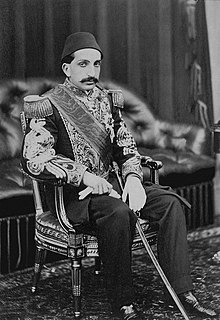Abd al-Hamid II
| Full name | |
|---|---|
| Abdul Hamid bin Abdul Mecid | |
| Era name and dates | |
| Decline and modernization of the Ottoman Empire: 1828–1908 |
Abdul Hamid II (Ottoman Turkish: عبد الحميد ثانی, `Abdü’l-Ḥamīd-i sânî; Turkish: İkinci Abdülhamit; 21 September 1842 – 10 February 1918) was the 34th Sultan of the Ottoman Empire and the last Sultan to exert effective control over the fracturing state. He oversaw a period of decline. He ruled from 31 August 1876 until he was deposed shortly after the 1908 Young Turk Revolution, on 27 April 1909. In accordance with an agreement made with the republican Young Ottomans, he promulgated the first Ottoman constitution of 1876 on 23 December 1876, which was a sign of progressive thinking that marked his early rule. Later, however, he noticed Western influence on Ottoman affairs and citing disagreements with Parliament, suspended both the short-lived constitution and Parliament in 1878 accomplished highly effective power and control.
Modernization of the Ottoman Empire occurred during his reign, including reform of the bureaucracy, the extension of the Rumelia Railway and Anatolia Railway and the construction of the Baghdad Railway and Hejaz Railway. In addition, a system for population registration and control over the press was established along with the first local modern law school in 1898. The most far-reaching of these reforms were in education: many professional schools were established, including Law School, School of Arts, School of Trades, Civil Engineering School, The Veterinarian School, The Customs School, The Farming School, The Linguistic School, and more. The University of Istanbul, although shut down by Abdul Hamid in 1881, was reopened in 1900, and a network of secondary, primary, and military schools was extended throughout the empire. Railway and telegraph systems were developed by primarily German firms. Between 1871 and 1908, the Sublime Porte thus "reached a new degree of organizational elaboration and articulation.",
...
Wikipedia


